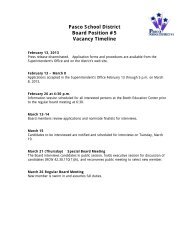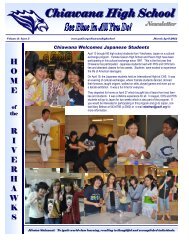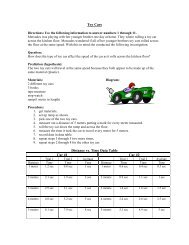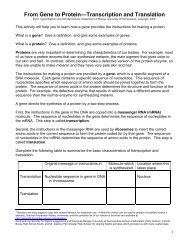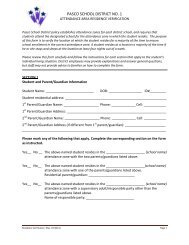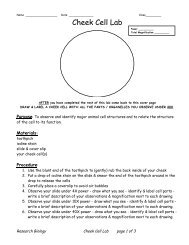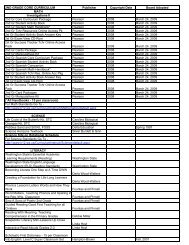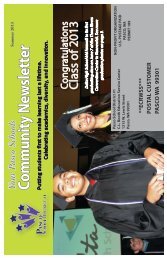You also want an ePaper? Increase the reach of your titles
YUMPU automatically turns print PDFs into web optimized ePapers that Google loves.
2 Washington I N T H E P A C I F I C N O R T H W E S T<br />
➽ PLACES TO LOCATE<br />
Pacific Rim<br />
Canada<br />
British Columbia<br />
Washington<br />
Oregon<br />
Idaho<br />
Five Regions:<br />
Coastal Range<br />
Puget Sound Lowlands<br />
Cascade Range<br />
Columbia Plateau<br />
Rocky Mountain<br />
Bitterroot Mountains<br />
Olympic Mountains<br />
Pacific Ocean<br />
Columbia River<br />
Snake River<br />
Grand Coulee Dam<br />
Seattle<br />
Tacoma<br />
Spokane<br />
Tri-Cities<br />
➽ WORDS TO<br />
UNDERSTAND<br />
arid<br />
commercial<br />
confluence<br />
finite<br />
formidable<br />
geography<br />
headwaters<br />
hinterland<br />
human characteristics<br />
hydroelectric<br />
physical features<br />
temperate<br />
tributaries<br />
Washington’s State Symbols:<br />
Flower: Coast Rhododendron Bird: Willow Goldfinch or Wild Canary Tree: Western<br />
Hemlock
The Far Corner:<br />
Washington’s<br />
Geography<br />
13<br />
1C h a p t e r<br />
Mt. Rainier, the Seattle skyline, and houseboats<br />
on Lake Union illustrate how people<br />
interact with their natural environment.<br />
Photo by Chuck Pefley<br />
Fish: Steelhead Fruit: Apple Insect: Green Darner Dragonfly
4 Washington I N T H E P A C I F I C N O R T H W E S T<br />
Trees are planted<br />
on a hillside near the<br />
Calawah River.<br />
Replanting is one of<br />
the ways lumber<br />
companies and<br />
government agencies<br />
are preserving the<br />
environment.<br />
Photo by Sunny Walter<br />
Geography and History<br />
The study of the natural features of the<br />
earth is called geography. Geography<br />
is also the study of where and how people<br />
live on the earth. Washington’s coastline,<br />
rivers, mountains, deserts, forests, and<br />
plateaus have always influenced where people<br />
live and what they do for a living. Our geography<br />
even influences what people do when<br />
they seek recreation or solitude in nature.<br />
The interaction between people and<br />
their environment is one of the most useful<br />
ways to study history. Consider how formidable<br />
nature’s obstacles were for the people<br />
who traveled by boat, foot, and later by<br />
wagon. It must have been terrifying to cross<br />
wide fast rivers and clear a path through<br />
steep mountain passes with rocky cliffs<br />
falling hundreds of feet below. It was common<br />
for pioneers to view the environment<br />
as an obstacle that needed to be subdued.<br />
Physical and Human<br />
Characteristics<br />
All locations have physical features<br />
that make them different from other<br />
places on earth. Physical features are<br />
natural to the environment and include<br />
mountains, rivers, soil, and climate, as well<br />
as plant and animal life. Washington has a<br />
striking diversity of physical features. If you<br />
travel around the state, you will see rocky<br />
beaches, beautiful islands, miles of forests,<br />
mountains, volcanoes, deep river gorges,<br />
deserts, and rich farmland.<br />
A place is also defined by changes made<br />
by people. We call these human characteristics.<br />
What we have built and how we<br />
have altered our physical environment in<br />
other ways help to define the place we call<br />
Washington. Large cities, freeways, dams,<br />
bridges, and acres of apple trees seem natural<br />
to us, but they have not always been here.<br />
Preserving the Environment<br />
There was so much land and so many<br />
forests on the frontier that settlers thought<br />
natural resources were limitless. Americans<br />
saw in the West a supply of resources they<br />
thought would last forever. A careless, wasteful<br />
attitude toward the environment was<br />
People change the land by building roads, railroads,<br />
and dams. This is Box Canyon Dam on<br />
the Pend Oreille River. Photo by Sunny Walter<br />
W H A T D O Y O U T H I N K ?<br />
Only in the late twentieth century did<br />
most Americans come to recognize<br />
that our resources are finite and that<br />
the environment is more fragile than<br />
we had realized. Think about modern<br />
development. Think about the vital<br />
importance of protecting our environment.<br />
What can be done to satisfy<br />
both needs?
T H E F A R C O R N E R : W A S H I N G T O N ’ S G E O G R A P H Y 5<br />
common. Too many trees were cut down.<br />
Too many wild animals were killed. Too many<br />
salmon were taken from the water.<br />
Later, rivers were dammed to supply<br />
water for irrigation and power to run electric<br />
generators. Railroads and highways were built<br />
through the mountains. Large parts of the<br />
Puget Sound region have actually been paved<br />
over by the many buildings, parking lots, and<br />
roads of large cities. Water and air pollution<br />
have become serious health concerns.<br />
Today, companies act more responsibly<br />
when they cut down forests, build roads, and<br />
fish commercially. Laws have been passed<br />
that protect our water, land, plant and animal<br />
life, and the air we breathe. People are careful<br />
not to litter, and they try to conserve our<br />
natural resources. We have subdued the environment,<br />
but are we responsible enough to<br />
live in harmony with it?<br />
One way the people of eastern Washington have changed their dry natural environment is by irrigation. Ditches carry water<br />
from man-made reservoirs to farmers’ fields. The farms on the right would not be possible without irrigation.<br />
Factories make the<br />
things we all want.<br />
They can also pollute<br />
the air and<br />
water if strict guidelines<br />
are not followed.<br />
Photo by Shirlee<br />
Simon-Glaze
6 Washington I N T H E P A C I F I C N O R T H W E S T<br />
Location<br />
The location of a place is like an<br />
address. Washington is located<br />
between the 46th and 49th parallels<br />
north latitude. It is between 117 degrees<br />
and 125 degrees west longitude. You can<br />
follow these lines around the world.<br />
Some of Washington’s boundaries are<br />
natural features of the land. Others were<br />
decided by people.<br />
• British Columbia, a Canadian province, is<br />
north of Washington.<br />
PHYSICAL AND POLITICAL WASHINGTON<br />
49˚<br />
48˚<br />
47˚<br />
46˚<br />
CANADA<br />
STRAIT OF JUAN DE FUCA<br />
Ozette L.<br />
Sol Duc R.<br />
Olympic NP<br />
Forks<br />
P a c i f i c<br />
O c e a n<br />
Long Beach<br />
Ilwaco<br />
124˚<br />
Vancouver<br />
Island<br />
Aberdeen<br />
Port Angeles<br />
Westport<br />
L. Crescent<br />
Olympic NP<br />
Quinault River<br />
L. Cushman<br />
Raymond<br />
South Bend<br />
Pt. Roberts<br />
Blaine<br />
SAN JUAN ISLANDS<br />
Port Townsend<br />
Sequim<br />
Shelton<br />
Oakville<br />
Friday Harbor<br />
Anacortes<br />
Oak Harbor<br />
Olympia<br />
A dmi r al t y I n<br />
Poulsbo<br />
Pe Ell<br />
Mayfield L.<br />
Winlock<br />
Vader<br />
Longview<br />
Bremerton<br />
Coupeville<br />
l e t<br />
Castle Rock<br />
L. Merwin<br />
Lynden<br />
Ferndale<br />
Normandy Park<br />
Gig Harbor<br />
Fort Lewis<br />
Chehalis<br />
Woodland<br />
La Conner<br />
Langley<br />
Mukilteo<br />
Edmonds<br />
Seattle<br />
Lacey<br />
Tenino<br />
Centralia<br />
Kelso<br />
Retsil<br />
Bellingham<br />
Mossyrock<br />
North Cascades NP<br />
L. Whatcom<br />
L. Washington<br />
Eatonville<br />
Alder L.<br />
Riffe L.<br />
Arlington<br />
Sammamish L.<br />
Swift Res.<br />
Yale L.<br />
Battle Ground<br />
Vancouver<br />
Sedro-Woolley<br />
Mount Vernon<br />
Marysville<br />
Lynnwood<br />
Issaquah<br />
Renton<br />
Kent<br />
Tacoma<br />
122˚<br />
Everett<br />
Bellevue<br />
Enumclaw<br />
Baker L.<br />
L. Shannon<br />
Mount Rainier NP<br />
Britis<br />
Darrington<br />
Index<br />
Skykomish<br />
Rimrock L.<br />
COLUMBIA RIVER<br />
124˚<br />
123˚<br />
122˚
T H E F A R C O R N E R : W A S H I N G T O N ’ S G E O G R A P H Y 7<br />
• The Pacific Ocean forms the western boundary.<br />
• Idaho and Oregon are on the other sides.<br />
Which river forms our southern border?<br />
A Hinterland<br />
Washington is located on the “far corner”<br />
of the United States. For much of its history,<br />
Washington’s remote location has resulted in<br />
a hinterland status. Hinterland is a term<br />
used by geographers to describe a region that<br />
is far from other settled areas. Hinterland<br />
regions are usually the last to be explored<br />
and populated. They usually export raw materials<br />
and import many manufactured goods.<br />
121˚<br />
Columbia CANADA<br />
Naches R.<br />
Klickitat R.<br />
Ross L.<br />
Ross Lake NRA<br />
Kachess L.<br />
Roslyn<br />
North Cascades NP<br />
Cashmere<br />
Yakima R.<br />
Goldendale<br />
Winthrop<br />
Lake<br />
Chelan NRA<br />
Wapato<br />
Toppenish<br />
L. Umatilla<br />
L. Chelan<br />
Chelan<br />
Entiat<br />
Leavenworth<br />
Naches<br />
Yakima<br />
Union Gap<br />
Conconully<br />
Twisp<br />
Brewster<br />
Waterville<br />
COLUMBIA RIVER<br />
Granger<br />
Grandview<br />
Okanogan R.<br />
Omak<br />
Okanogan<br />
Quincy<br />
Omak L.<br />
Nespelem Coulee<br />
Dam NRA<br />
Bridgeport<br />
Elmer City<br />
Electric City<br />
Franklin D.<br />
Mansfield<br />
Banks L. Roosevelt L. Creston<br />
Almira<br />
Hartline<br />
Coulee City<br />
Harrington<br />
Wilson Creek<br />
Moses L.<br />
George<br />
Potholes Res.<br />
Royal City<br />
Mattawa<br />
Prosser<br />
Oroville<br />
Tonasket<br />
Riverside<br />
East Wenatchee Bench<br />
Wenatchee<br />
Ellensburg<br />
120˚<br />
Ephrata<br />
Richland<br />
L. Wallula<br />
119˚<br />
Moses Lake<br />
Othello<br />
Hatton<br />
Connell<br />
Mesa<br />
Warden<br />
Sanpoil River<br />
Lind<br />
<strong>Pasco</strong><br />
Kennewick<br />
Republic<br />
Odessa<br />
Kahlotus<br />
Snake River<br />
Prescott<br />
L. Sacajawea<br />
Garrett<br />
COLUMBIA<br />
Marcus<br />
Kettle Falls<br />
Ritzville<br />
118˚<br />
Colville<br />
Medical Lake<br />
Washtucna<br />
Springdale<br />
Starbuck<br />
Deer Park<br />
Sprague<br />
PEND OREILLE R.<br />
Long L.<br />
Rock L.<br />
St. John<br />
Dayton<br />
Walla Walla<br />
Metaline Falls<br />
Metaline<br />
Ione<br />
Chewelah<br />
Spokane<br />
La Crosse<br />
Cheney<br />
Colfax<br />
Cusick<br />
Newport<br />
Spokane Valley<br />
SPOKANE R.<br />
Spangle<br />
Rosalia<br />
Pullman<br />
Garfield<br />
Palouse<br />
Albion<br />
Colton<br />
Clarkston<br />
Liberty Lake<br />
Asotin<br />
117˚<br />
49˚<br />
48˚<br />
IDAHO<br />
47˚<br />
46˚<br />
L. Celilo<br />
121˚<br />
OREGON<br />
120˚<br />
119˚<br />
118˚<br />
117˚
Gulls hover over the<br />
water after a storm<br />
on the Olympic<br />
Peninsula.<br />
Photo by Sunny Walter<br />
The Mighty Ocean<br />
Our state’s western border is the<br />
Pacific Ocean. Washington has only<br />
157 miles of ocean coastline, but<br />
there are over 3,000 miles of shoreline<br />
along the Strait of Juan de Fuca, the numerous<br />
bays and inlets of Puget Sound, and<br />
around the islands.<br />
Washington has more deep-water harbors<br />
than either California or Oregon. Shipping<br />
goods in and out of our harbors links<br />
Washington to the rest of the world. The<br />
Pacific Ocean and Puget Sound are the<br />
source of the state’s commercial fishing<br />
industry. Fishing provides less than one percent<br />
of the state’s income, but it is still significant.<br />
Salmon accounts for about one-third<br />
of the fishing income, followed by oysters,<br />
crabs, and shrimp. Other fish caught in ocean<br />
waters are halibut, flounder, tuna, and cod.<br />
A freighter is outbound from Grays Harbor.<br />
Photo by Robert Esposito<br />
A Mild Climate<br />
More important than the beautiful<br />
scenery it provides, the ocean has an important<br />
influence on our land and climate.<br />
Westerly winds from the Pacific give<br />
Washington a temperate climate. This is<br />
because the temperature of large bodies of<br />
water does not change as quickly as the<br />
temperature of the air. The warmer water of<br />
the ocean warms up the air next to it. Winds<br />
pick up the warmer air and carry it across<br />
the land.
T H E F A R C O R N E R : W A S H I N G T O N ’ S G E O G R A P H Y 9<br />
Compare the wet rain forest along<br />
the coast to the dryness of the<br />
land east of the mountains. What<br />
are the two main landforms that<br />
cause the differences in climate?<br />
Photo of rain forest by Tom Till. Photo of sagebrush<br />
on the plateau by Mike Green<br />
The Rain Shadow Effect<br />
High mountain ranges<br />
greatly affect the climate<br />
of a place. Here is what happens.<br />
Far out over the Pacific<br />
Ocean, winds pick up moisture<br />
from evaporating ocean<br />
water. The moist air blows<br />
over the coast and continues<br />
east. When the air reaches<br />
the mountains, it must rise to<br />
get over them. As air rises, it<br />
cools. Cool air cannot hold<br />
as much moisture as warm<br />
air does, so the moisture falls<br />
to the earth as rain or snow.<br />
This means that the land<br />
along the coast and on the<br />
west side of the Cascade<br />
Mountains is rainy. Some parts<br />
of western Washington<br />
receive over 100 inches of rain<br />
per year. It rains almost every<br />
day. Washington’s west side is<br />
often called the “wet side.”<br />
By the time the winds go<br />
up over the mountains and<br />
reach the east side of the<br />
Cascades, the air has very little<br />
moisture left. The dry<br />
winds continue east. This is<br />
why the eastern regions of<br />
the state are so dry. Some<br />
arid regions in Washington<br />
receive less than six inches of<br />
rain each year.<br />
Pacific<br />
Ocean<br />
Coastal<br />
Plain<br />
Moist Wind<br />
▲<br />
▲<br />
▲<br />
Dry Wind<br />
▲<br />
▲<br />
Columbia<br />
Plateau
10 Washington I N T H E P A C I F I C N O R T H W E S T<br />
Regions<br />
Regions are places that share common<br />
features. There are land regions,<br />
political regions, and commercial<br />
regions. You live in several different regions<br />
at the same time. You might live in a city, a<br />
county, a voting district, a school sports<br />
region, and the Pacific Northwest.<br />
The Pacific Rim—a Trading Region<br />
The Pacific Rim is a huge trading region<br />
that includes all the countries that border<br />
the Pacific Ocean. Each country around<br />
the rim makes products that other countries<br />
want to buy. For example, the people<br />
of the United States buy clothing made in<br />
China and the Philippines. We buy cars,<br />
televisions, and electronic equipment<br />
made in Japan. Washington exports aircraft,<br />
wheat, fruit, and computer software<br />
to China, Japan, Korea, and many other<br />
countries on the Pacific Rim.<br />
Goods in large metal cases are constantly<br />
being shipped across the Pacific. The<br />
ships move in and out of port cities in<br />
Washington, Oregon, and California. Ships<br />
from the East Coast and Europe come here<br />
too, passing first through the Panama Canal.<br />
In our port cities, goods are loaded onto<br />
trucks and trains and moved to other places<br />
in the United States and Canada.<br />
The Pacific Northwest<br />
The Pacific Northwest is a region of<br />
states that share similar landforms and<br />
early pioneer history. Washington, Oregon,<br />
and Idaho have tall snowy mountains and<br />
rushing rivers. Evergreen forests, dry grasslands,<br />
and farming valleys are part of the<br />
whole region. The region is divided from<br />
the rest of the United States by the Rocky<br />
Mountains.<br />
As you read through the chapters of this<br />
book, you will notice that our early history<br />
is the same as the early history of the other<br />
states in the Pacific Northwest. Indians<br />
moved freely across the land. Then fur trappers,<br />
missionaries, and pioneer settlers<br />
came to what was called the Oregon<br />
Country. It included today’s Idaho,<br />
Washington, and Oregon.<br />
THE PACIFIC NORTHWEST<br />
WASHINGTON<br />
THE PACIFIC RIM<br />
OREGON<br />
IDAHO<br />
ASIA<br />
NORTH AMERICA<br />
AUSTRALIA<br />
SOUTH<br />
AMERICA<br />
Landforms<br />
Landforms are features of the earth’s<br />
surface. They are the result of powerful<br />
forces moving inside and outside the earth’s<br />
surface. Some of these forces result in volcanoes<br />
and earthquakes. Others move<br />
oceans and even continents. Landforms are<br />
also the result of wind and water wearing<br />
away the earth’s surface.
T H E F A R C O R N E R : W A S H I N G T O N ’ S G E O G R A P H Y 11<br />
LANDFORMS<br />
Mountain:<br />
high rugged land<br />
Valley or Basin:<br />
lower land between<br />
mountains and plateaus.<br />
Cities and farms are in<br />
the valleys.<br />
City<br />
Plateau:<br />
high wide flat land many miles across<br />
Mouth of River:<br />
where a river opens into<br />
a larger body of water<br />
Farm<br />
Peninsula:<br />
a piece of land that<br />
sticks out into the<br />
water and that has<br />
water on three sides<br />
Harbor:<br />
a sheltered part<br />
of a body of water<br />
deep enough for<br />
anchoring ships<br />
Bay:<br />
a body of water<br />
that curves into<br />
the coastline<br />
Strait:<br />
a narrow<br />
passageway<br />
of water<br />
Coastline:<br />
the shape or outline<br />
of a coast<br />
Island:<br />
a body of land<br />
completely surrounded<br />
by water<br />
Washington’s Five Land Regions<br />
Washington can be divided into five land<br />
regions. Each region has at least one main<br />
type of landform, but may contain more.<br />
Major landforms are mountains and hills,<br />
plateaus (high, wide, flat areas hundreds of<br />
miles across), and lowlands that stretch to<br />
the ocean. Basins (wide bowl-shaped areas<br />
also called valleys) are surrounded by<br />
mountains or plateaus. Rivers, oceans, and<br />
lakes are also called landforms because they<br />
are natural features of the earth.<br />
Each of our state’s land regions is<br />
unique. Starting at the western coast and<br />
moving across the state, the land regions<br />
are:<br />
• Coastal Range<br />
• Puget Sound Lowlands<br />
• Cascade Range<br />
• Columbia Plateau<br />
• Rocky Mountain<br />
Coastal<br />
Range<br />
WASHINGTON’S LAND REGIONS<br />
Puget Sound<br />
Lowlands<br />
Cascade<br />
Range<br />
Columbia<br />
Plateau<br />
Rocky<br />
Mountain
12 Washington I N T H E P A C I F I C N O R T H W E S T<br />
The Coastal Range Region<br />
On the Olympic Peninsula there is a<br />
rain forest that supports such a profusion<br />
of plant life that naturalist Roger Tory<br />
Peterson proclaimed it “the greatest weight<br />
of living matter, per acre, in the world.”<br />
This narrow region offers the beauty of the<br />
Pacific Coast, the rainforest you can see on<br />
page 9, the snowcapped Olympic<br />
Mountains, and the thick forests. Olympic<br />
National Park is part of this region.<br />
There is little industry in the region<br />
since most lumber mills have closed and<br />
commercial fishing is in decline. The small<br />
towns rely on tourism.<br />
There are five Indian reservations on<br />
the coast and one along the strait.<br />
Coastal<br />
Range<br />
The Olympics are<br />
jagged mountains<br />
with snowcapped<br />
peaks year round.<br />
Photo by Eugene Kiver<br />
A gray whale comes<br />
right up to a tour<br />
boat near Westport.<br />
Photo by Sunny Walter<br />
The Puget Sound Lowlands<br />
Large cities such as Seattle, Tacoma,<br />
Bellevue, Bremerton, Bellingham, Everett,<br />
and Olympia, the state capital, make this<br />
region the population center of the state.<br />
Seattle is the heart of the region. Home to<br />
Microsoft, one of the world’s largest corporations,<br />
this region boasts one of the<br />
highest per capita income levels in the<br />
country. Traffic congestion is considered<br />
one of the worst in the country. This is a<br />
bustling, crowded, exciting, prosperous<br />
region.<br />
Deep-water seaports on Puget Sound<br />
and other ports on the Columbia River are<br />
important for the shipping industry. The<br />
bays, harbors, and San Juan Islands are popular<br />
recreation and vacation places.<br />
Not everyone in the lowlands lives in<br />
cities, of course. One of the state’s richest<br />
farming areas is the Skagit River Valley.<br />
Tulips and daffodils are the most famous<br />
crop. Peas, carrots, cauliflower, broccoli,<br />
and other crops are grown for their seeds<br />
or are canned or frozen. The Cowlitz and<br />
Chehalis River Valleys are also farming<br />
regions. Dairy cattle and chickens are<br />
raised for profit.
T H E F A R C O R N E R : W A S H I N G T O N ’ S G E O G R A P H Y 13<br />
Puget<br />
Sound<br />
Lowlands<br />
Miles of daffodils and tulips are grown in the<br />
Skagit Valley near Mt. Vernon. Selling the<br />
flowers and bulbs brings income to the people<br />
there. Photo by Chuck Pefley<br />
Seattle shines at<br />
sunset. Photo by Chuck Pefley<br />
Tacoma and<br />
Commencement Bay<br />
on Puget Sound are<br />
seen from the air.<br />
Seattle is in the distance.<br />
Photo by Chuck Pefley<br />
A ferryboat glides<br />
between islands on<br />
the Strait of Juan de<br />
Fuca. Photo by Chuck Pefley
14 Washington I N T H E P A C I F I C N O R T H W E S T<br />
Glacier Peak towers<br />
in the North<br />
Cascades.<br />
The Cascade Range Region<br />
The Cascade Mountain range, with its<br />
high volcanic peaks and many glaciers, is<br />
considered Washington’s most prominent<br />
geographic feature. These rugged mountains<br />
cut across the state, dividing the land sharply.<br />
They are a barrier to commerce and travel.<br />
The mountains are sometimes called the<br />
“Cascade Curtain.” This term recognizes the<br />
very different interests of the large seaport<br />
and manufacturing cities in the west and<br />
the less-populated agricultural regions in<br />
the east.<br />
The mountains also contribute to the<br />
startling differences in climate and rainfall<br />
between the eastern and western sections<br />
of the state. The land to the west of the<br />
mountains is rainy. Hemlocks, firs, and<br />
cedar forests grow in the damp climate. The<br />
forests of the western slopes are thick with<br />
mosses, ferns, and bushes growing beneath<br />
the trees. The eastern mountain slopes get<br />
Cascade<br />
Range
T H E F A R C O R N E R : W A S H I N G T O N ’ S G E O G R A P H Y 15<br />
much less rain, so sparse ponderosa pine<br />
forests flourish there.<br />
Five famous mountains are part of this<br />
region—Mt. St. Helens, Mt. Rainier, Mt.<br />
Adams, Mt. Baker, and Glacier Peak. Lake<br />
Chelan is also part of the region.<br />
Two national parks, the North Cascades<br />
and Mt. Ranier, bring thousands of visitors<br />
to view the breathtaking beauty of the<br />
mountains. You will read more about Mt. St.<br />
Helens in <strong>Chapter</strong> 2.<br />
Mountain Travel<br />
The Cascades are not the great obstacle to travel<br />
they were in past years, though two of the five<br />
mountain passes are closed in the winter. Early<br />
wagon roads across the mountains were a dangerous<br />
adventure. Railroad access came only late in the<br />
1800s. Now the four-lane Interstate 90 traverses the<br />
mountains through Snoqualmie Pass. When winter<br />
snows pile up and the threat of avalanches is great,<br />
however, Snoqualmie Pass can be closed for days at<br />
a time. Travelers just have to wait.<br />
Photo by Barbara MacNulty<br />
Travel over Snoqualmie Pass was quite different in 1919 than<br />
in 2000. The trip from Seattle to Spokane took three days in<br />
1919. It takes four or five hours today. Photo by Mike Green<br />
Snoqualmie Pass<br />
•
16 Washington I N T H E P A C I F I C N O R T H W E S T<br />
The climate and soil<br />
of the Columbia<br />
Plateau prove ideal<br />
for growing grapes.<br />
Washington’s wine<br />
industry has flourished<br />
in recent years.<br />
Photo by Otto Stevens<br />
The Columbia Plateau<br />
On the other side of the Cascades is the<br />
Columbia Plateau region. The high flat<br />
plateau covers most of eastern Washington<br />
and parts of Oregon and Idaho. It includes<br />
some of the driest land in the Pacific<br />
Northwest. Natural vegetation ranges from<br />
grassland to desert sagebrush.<br />
The region includes the wheat growing<br />
area of the Palouse and the huge Columbia<br />
Basin Irrigation Project made possible by<br />
Grand Coulee Dam. These irrigated lands<br />
grow a large variety of crops, including<br />
apples, cherries, grapes, corn, and alfalfa.<br />
Spokane is the metropolitan center of<br />
the Columbia Plateau. Spokane is the commercial,<br />
financial, and medical center of a<br />
large region covering parts of surrounding<br />
states and southern British Columbia.<br />
Other cities on the plateau are Yakima,<br />
Moses Lake, Wenatchee, Walla Walla,<br />
Pullman, and the Tri-Cities (Richland,<br />
<strong>Pasco</strong>, and Kennewick).<br />
W H A T D O Y O U T H I N K ?<br />
Why do you think the cities on the<br />
Puget Sound Lowlands attract more<br />
people than places on the Columbia<br />
Plateau? What factors of geography<br />
affect where people start cities, where<br />
industry thrives, and where farming<br />
is successful?<br />
Moving water has cut<br />
deep canyons and<br />
river gorges through<br />
the rock at Palouse<br />
Falls. Photo by Barbara<br />
Murray<br />
Columbia<br />
Plateau<br />
Wheat and peas as<br />
far as the eye can see<br />
are harvested in the<br />
Palouse Hills. Photo by<br />
Otto Stevens
T H E F A R C O R N E R : W A S H I N G T O N ’ S G E O G R A P H Y 17<br />
Spokane is seen from<br />
the North Hill across<br />
to South Hill.<br />
Photo by Chuck Pefley<br />
“I<br />
f there is<br />
magic on this<br />
earth it lies in<br />
water, and<br />
nowhere is water<br />
so beautiful as in<br />
the desert, for<br />
nowhere else is it<br />
so scarce. . . . In<br />
the desert each<br />
drop is precious.”<br />
—Edward Abbey<br />
Washington State<br />
University lies in the<br />
beautiful town of<br />
Pullman. Photo by Chuck<br />
Pefley
18 Washington I N T H E P A C I F I C N O R T H W E S T<br />
T H E C O L U M B I A R I V E R<br />
The Columbia River<br />
flows to the Pacific<br />
Ocean, forming the<br />
border between<br />
Washington and<br />
Oregon.<br />
Photo by Chuck Pefley<br />
Our southern border is formed by<br />
the “Great River of the West,” as it<br />
was called by early explorers. The<br />
river has its headwaters at Columbia Lake,<br />
high in British Columbia, Canada. The river<br />
enters Washington flowing south, then<br />
sweeps around the “Big Bend” to its confluence<br />
with the Snake River. Carrying the<br />
water of both rivers, the Columbia turns<br />
west. Cutting through the Cascades in the<br />
spectacular Columbia Gorge, the river continues<br />
to flow to the sea.<br />
When summer arrives and mountain<br />
snow melts, what happens to all the water?<br />
Much of it flows in thousands of tiny<br />
streams into larger streams, then into rivers.<br />
These tributaries eventually become part<br />
of the mighty Columbia River, and the water
T H E F A R C O R N E R : W A S H I N G T O N ’ S G E O G R A P H Y 19<br />
flows into the Pacific Ocean. In this way,<br />
the Columbia River drains water from the<br />
mountains like the drain in a sink.<br />
The river’s course across the state helps to<br />
explain much of Washington’s history. Early<br />
explorers hoped it would provide a waterway<br />
all the way across the continent. Indian tribes<br />
and early fur trappers relied on it for transportation<br />
in their large canoes and as a source<br />
of food. The river became the source of a thriving<br />
commercial salmon industry. Railroads<br />
followed its route through the Cascades,<br />
while steamboats braved its wild waters.<br />
The river’s huge volume of water,<br />
together with its very steep fall in elevation,<br />
makes it the most powerful river in North<br />
America in terms of hydroelectric energy.<br />
Major dams on the river produce more<br />
electricity than any other state. By the late<br />
1900s, the Columbia had been so altered by<br />
dams it was called an “engineered” river.<br />
The wild river was tamed. Roosevelt<br />
Reservoir behind Grand Coulee Dam and<br />
Banks Lake behind Dry Falls Dam are manmade<br />
lakes that are welcomed as recreation<br />
places in dry regions.<br />
Grand Coulee Dam provides electricity and flood control for<br />
the Columbia Plateau.<br />
Power lines carry electricity from the dams to the cities.<br />
Photo by Barbara Murray<br />
WASHINGTON’S MAJOR RIVERS<br />
Soleduck<br />
R.<br />
R.<br />
Elwha<br />
Quinault R.<br />
Skagit<br />
Cowlitz R.<br />
R.<br />
Ross<br />
Lake<br />
Naches R.<br />
Lake<br />
Chelan<br />
Yakima<br />
R<br />
Columbia R.<br />
.<br />
Okanogan R<br />
Columbia<br />
Banks<br />
Lake<br />
.<br />
R<br />
Grand Coulee<br />
Dam<br />
Snake<br />
Spokane<br />
R.<br />
Pend<br />
Roosevelt<br />
Reservoir<br />
R.<br />
Oreille R<br />
Kayaking is great<br />
sport on the rapids of<br />
the Elwha River. Photo by<br />
Sunny Walter<br />
Columbia<br />
R.
20 Washington I N T H E P A C I F I C N O R T H W E S T<br />
“Round ‘em up!”<br />
Ranchers take cattle<br />
from higher pastures<br />
to the lower valleys<br />
for the winter.<br />
Photo by Jim Oltersdorf<br />
Rocky<br />
Mountain<br />
A Generous Uncle Sam<br />
The Rocky<br />
Mountain Region<br />
This region in the corner<br />
of the state is sometimes<br />
called the Okanogan<br />
Highlands. The steep hills are foothills of<br />
the great Rocky Mountains.<br />
To make a living in this region, people<br />
rely on farming, mining lead and zinc,<br />
ranching, and lumbering. A few small towns<br />
depend on tourism. Native Americans live<br />
on three reservations.<br />
In early United States history, two factors greatly<br />
influenced every aspect of this region’s settlement<br />
and economic development:<br />
One was the vastness of the land—thousands and<br />
thousands of miles of open spaces far from settled<br />
areas in the East.<br />
The other was that the United States government<br />
either bought land from other countries, got it by<br />
Indian treaties, or won it in war. Then the government<br />
gave away, free or at very low cost, large pieces of<br />
land to pioneer homesteaders, cattlemen, timber companies,<br />
miners, and the railroad.<br />
National Parks<br />
National Park<br />
Date Created<br />
Mt. Rainier 1899<br />
Olympic 1938<br />
North Cascades 1963<br />
Klondike Gold Rush 1976<br />
(downtown Seattle)<br />
such as roads and buildings, are kept to a<br />
minimum. The parks are a refuge for natural<br />
plants and animals.<br />
Washington has three national parks and<br />
several national historic parks:<br />
Olympic National Park has a constant<br />
wet climate. On the ocean beaches<br />
of the park, you can search for interesting<br />
rocks and shells and climb on huge driftwood<br />
logs that have been carried ashore<br />
by the ocean. Just beyond the beaches, a<br />
rain forest, thick and green and full of<br />
many kinds of plants, is unique in North<br />
America. Only trails penetrate this mountain<br />
wilderness.<br />
Mt. Rainier National Park was the<br />
first national park in Washington and one<br />
of the first in the United States. A giant<br />
volcano is covered with glaciers. Lower<br />
slopes are decorated with dense forests<br />
and flowering meadows. Skilled mountain<br />
climbers find this highest peak in the<br />
state—and one of the highest in North<br />
America—a challenge. For other nature<br />
lovers, miles of high mountain roads offer<br />
splendid views.<br />
Washington’s<br />
National Parks<br />
National parks are government-protected<br />
places that are unique in some<br />
way. They are set aside so everyone<br />
can enjoy nature. Changes to the land,<br />
San Juan Island<br />
• • North Cascades<br />
•<br />
•<br />
Klondike Gold Rush<br />
Olympic Mount Rainier<br />
•
T H E F A R C O R N E R : W A S H I N G T O N ’ S G E O G R A P H Y 21<br />
North Cascades National Park is a<br />
breathtakingly beautiful place to visit.<br />
Jagged glaciated peaks loom above an<br />
alpine region of meadows, forests, fast-running<br />
streams, and spectacular waterfalls.<br />
The park is rich in wildlife.<br />
Klondike Gold Rush National<br />
Historic Park is located in downtown<br />
Seattle. The park tells the city’s historic role<br />
as the beginning site for trips to the Alaskan<br />
gold fields in the mid-1800s.<br />
San Juan Island National Historic<br />
Park is the site of British and American military<br />
campsites when the United States and<br />
Great Britain both claimed the islands.<br />
Whitman Mission National Historic<br />
Site is where Marcus and Narcissa Whitman<br />
started an Indian mission and were later<br />
massacred. The Whitmans provided education<br />
and religious instruction to the native<br />
people and assistance to pioneers on the<br />
Oregon Trail.<br />
Canada, Our<br />
Northern Neighbor<br />
An important feature of Washington’s<br />
geography is its border with Canada’s<br />
British Columbia. Relationships<br />
between the people in both countries are<br />
friendly. Many Canadian “snowbirds” spend<br />
winters in Florida or the U.S. Southwest.<br />
Vancouver Island and Victoria Island are<br />
favorite vacation places for U.S. tourists.<br />
There are, however, complicated trade<br />
issues about fishing rights, lumber sales,<br />
and pollution problems in shared waters.<br />
Since the Columbia River flows through<br />
Canada and the United States, both countries<br />
are concerned about the use of water<br />
for irrigation, shipping, fishing, and the<br />
electricity generated at the dams on the<br />
river. These issues involve negotiations<br />
between both national governments.<br />
Photo by Chuck Pefley<br />
CHAPTER 1 REVIEW<br />
1. Define geography and describe how geography<br />
and history are related.<br />
2. Define and give examples of physical and human<br />
characteristics of a place.<br />
3. Why did pioneers often regard the environment<br />
as an adversary?<br />
4. What are Washington’s most serious environmental<br />
problems?<br />
5. What can people do today to preserve the natural<br />
environment?<br />
6. Name the country, states, and bodies of water<br />
that form Washington’s boundaries.<br />
7. List at least two important ways that the Pacific<br />
Ocean affects the land and people of Washington.<br />
8. What are the three most common types of landforms<br />
in Washington? What bodies of water are<br />
also considered landforms?<br />
9. What type of region is the Pacific Rim? How does<br />
Washington’s place on the Pacific Rim give us an<br />
advantage in a global economy?<br />
10. List our state’s five land regions.<br />
11. Which two land regions have the highest population?<br />
12. Which land region is mostly at sea level, but also<br />
has a rainforest and mountains?<br />
13. Which land region is the driest?<br />
14. Name three large cities in the Puget Sound<br />
Lowlands.<br />
15. Name three land features or cities in the<br />
Columbia Plateau.<br />
16. The Columbia River has its headwaters in<br />
______________ ______________.<br />
17. Name a large tributary of the Columbia River.<br />
18. List at least three ways the Columbia and the<br />
dams on the river help the people of<br />
Washington.




